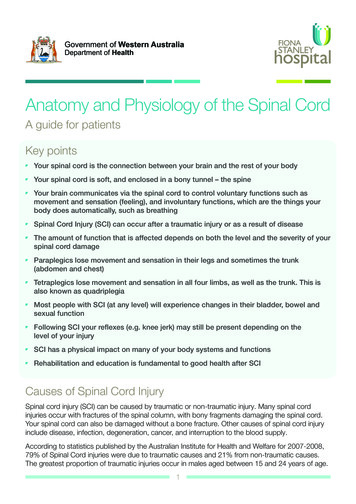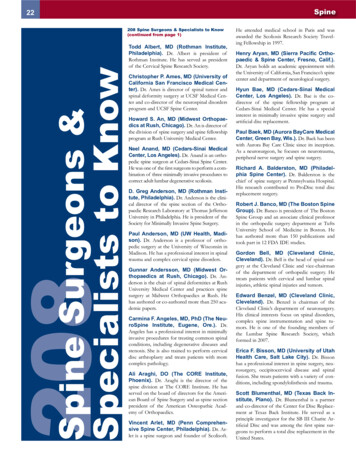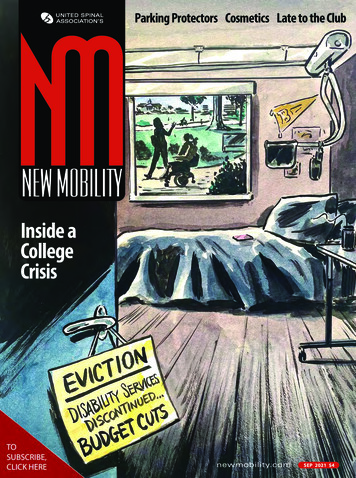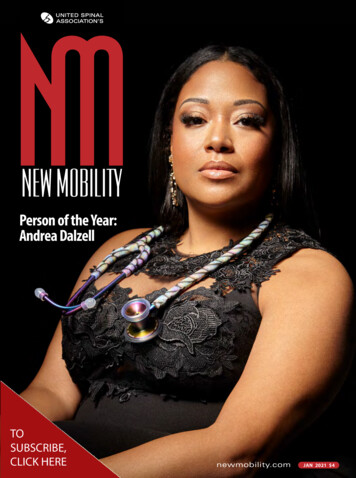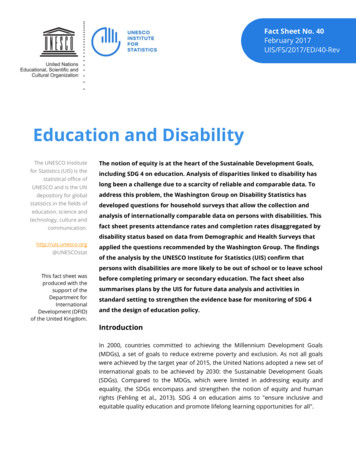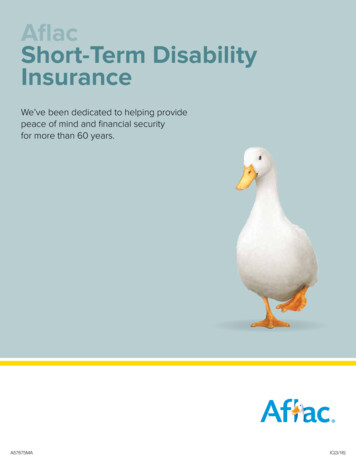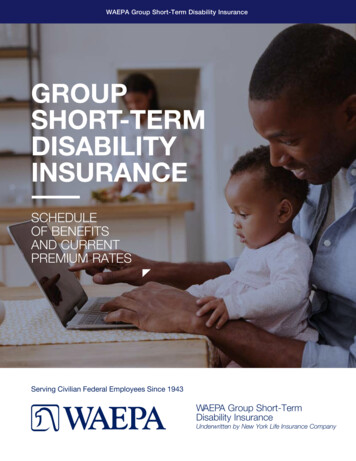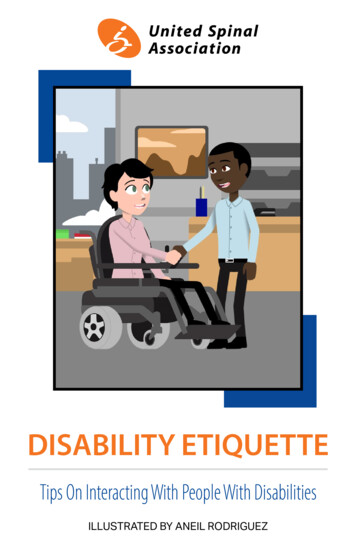
Transcription
DISABILITY ETIQUETTETips On Interacting With People With DisabilitiesILLUSTRATED BY ANEIL RODRIGUEZ
United Spinal AssociationMission StatementUnited Spinal Association is dedicated to enhancing the quality of life of all people living withspinal cord injuries and disorders, including veterans, and providing support and information toloved ones, care providers and professionals.Who We AreUnited Spinal Association is the largest non-profit in the United States dedicated to helpingpeople living with SCI/D. We are a 501(c)(3) national disability rights and veterans serviceorganization founded in 1946. United Spinal Association provides active-lifestyle information,peer support and advocacy that empowers people with SCI/D to achieve their highest potentialin all facets of life. United Spinal played a significant role in writing the Americans withDisabilities Act, the landmark civil rights law of 1990 that protects people with disabilities fromdiscrimination. It has also made important contributions to the Fair Housing Amendments Actand the Air Carrier Access Act, and was instrumental in getting New York City to create sidewalkcurb ramps and accessible public transportation that is currently used as a model for many citiesnationwide.Who We ServeUnited Spinal Association’s diverse membership includes wheelchair-users, veterans withdisabilities and people living with multiple sclerosis, amyotrophic lateral sclerosis, postpolio, spina bifida and other spinal cord disorders. Each year, United Spinal Association helpsthousands of people of all ages overcome the daily challenges of living life with a disability. Andwe extend our unending support to those most important in their lives––their family membersand caregivers.PublicationsTo download any of United Spinal Association’s informative publications free of charge, cations or call 800-444-0120 to order printedcopies.DonationsUnited Spinal Association receives very little government funding. Its programs and servicesdepend on individuals like you and your tax-deductable gifts. If you would like to make adonation to support United Spinal’s mission, please visit www.unitedspinal.org/donationsor call 800-404-2899.MembershipMembership in United Spinal Association is free and open to all individuals who are living witha spinal cord injury or disease, their family members, friends, and healthcare providers. For moreinformation, visit ociation/.TrainingUnited Spinal Association can customize a “Disability Etiquette” training session at a reasonablecost for your company, organization, or institution. Its experienced staff can plan a programbased on your needs. For more information, please contact info@unitedspinal.org.United Spinal Association120-34 Queens Boulevard #320, Kew Gardens, NY, 11415718 803 3782 www.unitedspinal.orgCopyright 2015 United Spinal Association. All Rights Reserved.2DISABILITY ETIQUETTEContentsAbout Us. 2Publications. 2Donations. 2Membership. 2Training. 2Introduction. 4The Basics. 4Ask Before You Help. 4Be Sensitive About Physical Contact. 4Think Before You Speak. 6Don’t Make Assumptions. 6Respond Graciously to Requests. 6Terminology Tips. 6People Who Use Wheelchairs or Other Mobility Devices. 7People Who Are Blind.11People With Low Vision.13People Who Are Deaf or Have a Hearing Loss.13People With Speech Disabilities.17Persons of Short Stature.19People With Cerebral palsy.19People With Tourette Syndrome.19People Who Look Different.21People With Hidden Disabilities.21People With Epilepsy or Seizure Disorders.22People With Multiple Chemical Sensitivity and Respiratory Disabilities. 22People With HIV and AIDS.23People With Psychiatric Disabilities or Mental Illness.25People With Intellectual Disabilities.26People with Learning Disabilities.27People with Traumatic (or Acquired) Brain Injury.29People Who Use Service Animals.29Emergency Evacuation Procedures for People With Disabilities.30Autistic People.31Conflict Management.33A Final Word.33Signage. Back CoverWWW.UNITEDSPINAL.ORG 1.800.444.01203
Introduction Terminology TipsThe United States Census Bureau reports that approximately 56.7 millionAmericans have a disability. This booklet is for anyone—with or withouta disability—who wants to interact more effectively with people withdisabilities. The Americans with Disabilities Act of 1990 was conceivedwith the goal of integrating people with disabilities into all aspects of life,particularly the workplace and the marketplace. Sensitivity toward peoplewith disabilities is not only in the spirit of the ADA, it makes good businesssense. It can help you expand your practice, better serve your customersor develop your audience. When supervisors and co-workers use disabilityetiquette, employees with disabilities feel more comfortable and work moreproductively. Practicing disability etiquette is an easy way to make people withdisabilities feel welcome.Speak directlyto a person witha disability.You don’t have to feel awkward when dealing with a person who has adisability. This booklet provides some basic tips for you to follow. And if youare ever unsure how to interact with a person who has a disability, just ask!The BasicsASK BEFORE YOU HELPJust because someone has a disability, don’t assume she needs help. If thesetting is accessible, people with disabilities can usually get around fine. Adultswith disabilities want to be treated as independent people. Offer assistanceonly if the person appears to need it. A person with a disability will oftentimescommunicate when she needs help. And if she does want help, ask how beforeyou act.BE SENSITIVE ABOUT PHYSICAL CONTACTSome people with disabilities depend on their arms for balance. Grabbingthem, even if your intention is to assist, could knock them off balance.not to hiscompanion orsign languageInterpreter.Avoid patting a person on the head or touching his wheelchair, scooter orcane. People with disabilities consider their equipment part of their personalspace.4DISABILITY ETIQUETTEWWW.UNITEDSPINAL.ORG 1.800.444.01205
THINK BEFORE YOU SPEAKAlways speak directly to the person with a disability, not to his companion, aideor sign language interpreter. Making small talk with a person who has a disabilityis great; just talk to him as you would with anyone else. Respect his privacy. If youask about his disability, he may feel like you are treating him as a disability, notas a human being. However, many people with disabilities are comfortable withquestions about their disability after getting to know someone. A simple “I don’tfeel comfortable sharing that” by the person with a disability can set the tone if itis not something that he/she/they are willing to share.It’s okay to use idiomatic expressions when talking to people with disabilities.For example, saying, “It was good to see you,” and “See you later,” to a person whois blind is completely acceptable; they use these expressions themselves all thetime.DON’T MAKE ASSUMPTIONSPeople with disabilities are the best judge of what they can or cannot do.Many people who are Deaf communicate with sign language and considerthemselves to be members of a cultural and linguistic minority group. Theyrefer to themselves as Deaf with a capital “D,” and may be offended by the term“hearing impaired.” Others may not object to the term, but in general it is safestto refer to people who have hearing loss but who communicate in spokenlanguage as “hard of hearing” and to people with profound hearing losses asDeaf or deaf.Don’t make decisions for them about participating in any activity. Depending onthe situation, it could be a violation of the ADA to exclude people because of apresumption about their limitations.People Who Use Wheelchairsor Other Mobility DevicesRESPOND GRACIOUSLY TO REQUESTSWhen people who have disabilities ask for an accommodation at yourbusiness, it is not a complaint. It shows they feel comfortable enough in yourestablishment to ask for what they need. And if they get a positive response,they will probably come back again and tell their friends about the good servicethey received.Terminology TipsPUT THE PERSON FIRST. Say “person with a disability” rather than “disabledperson.” Say “people with disabilities” rather than “the disabled.” For specificdisabilities, saying “person with Tourette syndrome” or “person who has cerebralpalsy” is usually a safe bet. Still, individuals do have their own preferences. If youare not sure what words to use, ask.Avoid outdated terms like “handicapped, crippled or retarded.” Be aware thatmany people with disabilities dislike jargony, euphemistic terms like “physicallychallenged” and “differently abled.” Say “person who uses a wheelchair” ratherthan “confined to a wheelchair” or “wheelchair bound.” The wheelchair is whatenables the person to get around and participate in society; it’s liberating, notconfining.With any disability, avoid negative, disempowering words like “victim” or“sufferer.” Say “person with AIDS” instead of “AIDS victim” or “person who suffersfrom AIDS.”6DISABILITY ETIQUETTEPEOPLE WHO USE WHEELCHAIRS have different disabilities and varyingabilities. Some can use their arms and hands. Some can get out of theirwheelchairs and even walk for short distances.People who use wheelchairs are individuals, not equipment. Don’t lean oversomeone who uses a wheelchair to shake another person’s hand or ask awheelchair user to hold coats. Setting your drink on the desktop attached tosomeone’s wheelchair is a definite no-no.u Don’t push or touch a person’s wheelchair; it’s part of her personal space. Ifyou help someone down a curb without waiting for instructions, you maydump her out of the chair. You may detach the chair’s parts if you lift it by thehandles or the footrest.u Keep the ramps and wheelchair-accessible doors to your building unlockedand unblocked. Under the ADA, displays should not be in front of entrances,wastebaskets should not be in the middle of aisles, and boxes should not bestored on ramps.u Be aware of a person’s reach limits. Place as many items as possiblewithin their grasp. And make sure there is a clear path of travel to shelves anddisplay racks. When talking to a person using a wheelchair, grab your ownchair and sit at her level. If that’s not possible, stand at a slight distance, sothat she isn’t straining her neck to make eye contact with you.u If the service counter at your place of business is too high for a personWWW.UNITEDSPINAL.ORG 1.800.444.01207
using a wheelchair to see over, step around it to provide service. Have aclipboard handy if filling in forms or providing signatures is expected. Abusiness may also want to make sure employees are prepared to angle downor detach a key pad so a person using a wheelchair can sign their electronicsignature after making a credit card purchase.Keep accessiblepaths oftravel clear.u If your building has different routes through it, be sure that signsdirect people to the accessible routes around the facility. People who usecanes or crutches also need to know the easiest way to get around a place,but stairs may be easier for them than a ramp. Ensure that security guards andreceptionists can answer questions about the most accessible way around thebuilding and grounds, including the location of elevators.u People who use canes or crutches need their arms to balance themselves,so never grab them. People who have limited mobility may lean on a door forsupport as they open it. Pushing the door open from behind or unexpectedlyopening the door may cause them to fall. Even pulling out or pushing in achair may present a problem. Always ask before offering help.u If you offer a seat to a person who has limited mobility, keep in mind thatchairs with arms or with higher seats are easier for some people to use.u Falls are a big problem for people who have limited mobility. Be sure toset out adequate warning signs after washing floors. Also put out mats onrainy or snowy days to keep the floors as dry as possible. (Make sure theydon’t bunch up and make the floor impassable.)u People who do not have a visible disability may have needs related to theirmobility. For example, a person with a respiratory or heart condition may havetrouble walking long distances or walking quickly. Be sure that your museum,hotel or department store has ample benches for people to sit and rest on.u Some people have limited use of their hands, wrists or arms. Beprepared to offer assistance with reaching, grasping or lifting objects,opening doors and display cases, and operating vending machines and otherequipment.8DISABILITY ETIQUETTEWWW.UNITEDSPINAL.ORG 1.800.444.01209
People Who Are BlindPEOPLE WHO ARE BLIND know how to orient themselves and get aroundon the street. They are competent to travel unassisted, though they may use acane or a guide dog. A person may have a visual disability that is not obvious. Beprepared to offer assistance—for example in reading—when asked.Don’t ask aperson using awheelchair tohold things foryou.u Identify yourself before you make physical contact with a person who isblind. Tell him your name and your role if it’s appropriate, such as securityguard, usher, case worker, receptionist or fellow student. And be sure tointroduce him to others who are in the group, so that he’s not excluded.u If a new customer or employee is blind or has low vision, offer him atour of your facility.u If you have changed your facility (i.e., rearranged the furniture) notifyyour customers who are blind of the changes.u People who are blind may need their arms for balance, so offer your arm—don’t take his—if they need to be guided. (It is however appropriate to guide ablind person’s hand to a banister or the back of a chair to help direct them to astairway or a seat.)Respect herpersonal space.u If the person has a guide dog, walk on the side opposite the dog. As youare walking, describe the setting, noting any obstacles, such as stairs (‘up’ or‘down’) or a big crack in the sidewalk. Other hazards include: revolving doors,half-opened filing cabinets or doors, and objects protruding from the wall athead level such as hanging plants or lamps. If you are going to give a warning,be specific. Hollering “Look out!” does not tell the person if he should stop,run, duck or jump.u If you are giving directions, give specific, non-visual information.Rather than say, “Go to your right when you reach the office supplies,” whichassumes the person knows where the office supplies are, say, “Walk forwardto the end of this aisle and make a full right.”u If you need to leave a person who is blind, inform him you are leaving and askif he needs anything before you leave.u Don’t touch the person’s cane or guide dog. The dog is working and needs toconcentrate. The cane is part of the individual’s personal space. If the personputs the cane down, don’t move it. Let him know if it’s in the way.10DISABILITY ETIQUETTEWWW.UNITEDSPINAL.ORG 1.800.444.012011
u Offer to read written information—such as the menu, merchandiselabels or bank statements—to customers who are blind. Count out change sothat they know which bills are which.If a personwho is blindneeds to beguided.u If you serve food to a person who is blind, let him know where it is onthe plate according to a clock orientation (12 o’clock is furthest from them,6 o’clock is nearest). Remove garnishes and anything that is not edible fromthe plate. Some patrons may ask you to cut their food; this can be done in therestaurant’s kitchen before the meal is served.People With Low VisionA PERSON WHO HAS LOW VISION may need written material in large print. Aclear font with appropriate spacing is just as important as the type size. Labelsand signs should be clearly lettered in contrasting colors. It is easiest for mostpeople with low vision to read bold white letters on black background. Avoidusing all uppercase letters because it is more difficult for people with low visionto distinguish the end of a sentence.u Good lighting is important, but it shouldn’t be too bright. In fact, very shinypaper or walls can produce a glare that disturbs people’s eyes.u Keep walkways clear of obstructions. If people with low vision regularly useyour facility as customers or employees, inform them about any physicalchanges, such as rearranged furniture, equipment or other items that havebeen moved.offeryour arm—don’t take his.People Who Are Deaf or Have a Hearing LossAMERICAN SIGN LANGUAGE is an entirely different language from English,with a syntax all its own. Lip reading is difficult for people who are Deaf if theirfirst language is ASL because the majority of sounds in English are formed insidethe mouth, and it’s hard to speech read a second language.People who have a hearing loss, however, communicate in English. They usesome hearing, but may rely on amplification and/or seeing the speaker’s lips tocommunicate effectively.There is a range of communication preferences and styles among peoplewith hearing loss that cannot be explained in this brief space. It is helpful tonote that the majority of people who incurred a hearing loss as adults do notcommunicate with sign language, do use English, and may be candidates for12DISABILITY ETIQUETTEWWW.UNITEDSPINAL.ORG 1.800.444.012013
writing and assistive listening devices to help improve communication. Peoplewith cochlear implants, like other people with hearing loss, will usually informyou what works best for them.Be specificwhen givingdirections.u When the exchange of information is complex (e.g., during a jobinterview or doctor’s visit or when reporting a crime) the most effective wayto communicate with a native signer is through a qualified sign languageinterpreter. For a simple interaction (e.g., ordering in a restaurant orregistering for a hotel room) writing back and forth is usually OK.u Follow the person’s cues to find out if she prefers sign language,gesturing, writing or speaking. If you have trouble understanding the speechof a person who is deaf or hard of hearing, let her know.u When using a sign language interpreter, look directly at the person whois deaf, and maintain eye contact to be polite. Talk directly to the person(‘What would you like?’), rather than to the interpreter (‘Ask her what she’dlike.’).u People who are deaf need to be included in the decision-making processfor issues that affect them; don’t decide for them.u Before speaking to a person who is deaf or has a loss of hearing, makesure that you get her attention. Depending on the situation, you can extendyour arm and wave your hand, tap her on the shoulder or flicker the lights. to peoplewho are blind orhave low vision.u Rephrase, rather than repeat, sentences that the person does notunderstand.u When talking, face the person. A quiet, well-lit room is most conduciveto effective communication. If you are in front of the light source (e.g., awindow) with your back to it, the glare may obscure your face and make itdifficult for the person who is hard of hearing to speech read.u Speak clearly. Most people who have a hearing loss count on watchingpeople’s lips as they speak to help them understand. Avoid chewing gum,smoking or obscuring your mouth with your hand while speaking.u There is no need to shout. If the person uses a hearing aid, it will becalibrated to normal voice levels; your shout will just distort the words.u People who are deaf and some who have a hearing loss or speech14DISABILITY ETIQUETTEWWW.UNITEDSPINAL.ORG 1.800.444.012015
When anexchange ofinformation iscomplex, themost effectiveway tocommunicatewith.disabilities make and receive telephone calls with the assistance of varioustechnologies including a TTY (short for teletypewriter) or a video relay service.VRS enables a person who is deaf or has a hearing loss to make and receivetelephone calls through a communications assistant who is a qualifiedAmerican Sign Language Interpreter. For many people who are deaf or havea hearing loss, VRS is closer to “functionally equivalent” telephone servicesthan any other form of relay service. For American Sign Language users, VRSconversations flow more smoothly, naturally, and faster than communicatingby typing.u When a TTY user calls a business that does not have a TTY, she placesthe call through her state’s relay service. Likewise, a business that does nothave a TTY can reach a customer who is a TTY user through the relay service.If you receive a relay call, the operator will identify it as such. Please do nothang up; this is the way that people who are deaf are able to place an order atyour pizza parlor, call your store to find out what hours you are open, or makea reservation at your restaurant.People With Speech DisabilitiesA PERSON WHO HAS HAD A STROKE, is deaf, uses a voice prosthesis or has astammer or other type of speech disability may be difficult to understand.a personwho is Deafis througha qualifiedsign languageinterpreter.u Give the person your full attention. Don’t interrupt or finish the person’ssentences. If you have trouble understanding, don’t nod. Just ask them torepeat. In most cases the person won’t mind and will appreciate your effort tohear what they have to say.u If you are not sure whether you have understood, you can repeatfor verification.u If, after trying, you still cannot understand the person, ask them to writeit down or to suggest another way of facilitating communication.u A quiet environment makes communication easier.u Don’t tease or laugh at a person with a speech disability. The ability tocommunicate effectively and to be taken seriously is important to all of us.16DISABILITY ETIQUETTEWWW.UNITEDSPINAL.ORG 1.800.444.012017
Persons of Short StatureTHERE ARE 200 DIAGNOSED TYPES OF GROWTH-RELATED DISORDERSthat can cause dwarfism and that result in the person being 4 feet 10 inches orless in height. For an adult, being treated as cute and childlike can be a toughobstacle.Do not obscureyour face whencommunicatingwith a personwho has ahearing loss.u Be aware of having necessary items within the person’s reach to themaximum extent possible.u Be aware that persons of short stature count on being able to useequipment that is at their height. Be sensitive about not using lowertelephones, bank counters and urinals if they are in limited supply.u As with people who have other disabilities, never pet or kiss a person ofshort stature on the head.u Communication can be easier when people are at the same level.Persons of short stature have different preferences. You might kneel to beat the person’s level; stand back so you can make eye contact without theperson straining her neck (this can be hard to do in a crowded room); or sit ina chair. Act natural and follow the person’s cues.People With Cerebral PalsyAS A RESULT OF INJURY TO THE CENTRAL NERVOUS SYSTEM, people withcerebral palsy have difficulty controlling their muscles.u Many people with CP have slurred speech and involuntary bodymovements. Your impulse may be to discount what they have to say, basedon their appearance. Monitor your responses and interact with the person asyou would with anyone else.u A person who may appear to be drunk, sick or have a medicalemergency might in fact have CP or another disability. Get the facts beforeacting on your first impression, whether the situation is business, social or lawenforcement.People With Tourette SyndromePEOPLE WITH TOURETTE SYNDROME may make vocalizations or gesturessuch as tics that they cannot control. A small percentage of people with Tourette18DISABILITY ETIQUETTEWWW.UNITEDSPINAL.ORG 1.800.444.012019
syndrome involuntarily say ethnic slurs or obscene words. An employee orother person with Tourette syndrome will benefit from the understanding andacceptance of co-workers and others.u If a person with Tourette makes vocalizations during a conversation,simply wait for her to finish, and then calmly continue.If youhave troubleunderstandinga person with.u The more the person tries to contain these urges, the more the urgesbuild up. It may be helpful for a person with Tourette to have the option toleave the meeting or conversation temporarily to release the build-up in aprivate place.People Who Look DifferentA DIFFERENT ISSUE confronts people who may not be limited in their lifeactivities, but who are treated as if they have a disability because of theirappearance. People with facial differences, such as cleft lip or palate, cranio-facialdisfigurement, or a skin condition; people who are above or below the averageheight or weight; people who may display visible effects of medication, such asa tremor—in short, people who look different—have the frequent experience offinding people staring at them, looking away or looking through them as if theyare invisible.u Everyone needs to have a positive self-image to be a fully participatingmember of society. Be sure that you don’t contribute to stigmatizing peoplewho look different.u If the situation is appropriate, strike up a conversation and include theperson in whatever is going on. a speechdisability askhim to repeat.People With Hidden DisabilitiesNOT ALL DISABILITIES ARE APPARENT. A person may make a requestor act in a way that seems strange to you. That request or behavior may bedisability-related.For example, you may give seemingly simple verbal directions to someone, butthe person asks you to write the information down. They may have a disabilitythat makes written communication easier for them. Or a person may ask to sit,rather than stand, in line. This person may be fatigued from a condition such ascancer, or may be feeling the effects of medication.20DISABILITY ETIQUETTEWWW.UNITEDSPINAL.ORG 1.800.444.012021
Even though these disabilities are hidden, they are real. Please respect theperson’s needs and requests whenever possible.People With Epilepsy or Seizure DisordersEPILEPSY IS A NEUROLOGICAL CON
Avoid outdated terms like "handicapped, crippled or retarded." Be aware that many people with disabilities dislike jargony, euphemistic terms like "physically challenged" and "differently abled." Say "person who uses a wheelchair" rather than "confined to a wheelchair" or "wheelchair bound." The wheelchair is what

